-
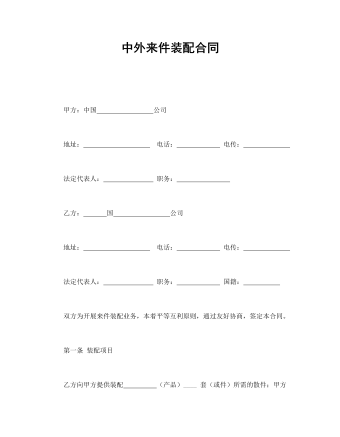
中外来件装配合同
第一条 装配项目乙方向甲方提供装配 (产品)____ 套(或件)所需的散件;甲方装配后将成品交付乙方。第二条 交付来件与加工成品的数量和时间乙方将于 年 月至 年 月 日,每月向甲方提供____散件____套,并负责运至____ 港口(或车站)交付甲方;在甲方收到散件后的____个月内(或自 年 月 日至 年 月 日)分批将装配后的成品负责运至 港口(或车站)交付乙方。第三条 加工费甲方为乙方进行装配的加工费,每件(或套)计 币 元。第四条 付款办法乙方将不作价的散件运交甲方,加工费由乙方给甲方开出即期付款信用证。第五条 来厂专家和技术培训根据实际需要,乙方有义务向甲方派遣专家并为甲方培训必要的技术人员,来厂专家和培训人员的数目、时间、任务、以及费用负担等,由双方另行商议。第六条 运费、保险费
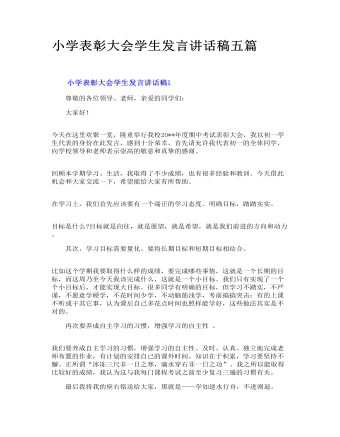
小学表彰大会学生发言讲话稿五篇
比如这个学期我要取得什么样的成绩,要完成哪些事情,这就是一个长期的目标,而这周乃至今天我该完成什么,这就是一个小目标。我们只有实现了一个个小目标后,才能实现大目标。很多同学有明确的目标,但学习不踏实,不严谨,不愿意学硬学,不花时间少学,不动脑筋浅学,考前搞搞突击;有的上课不听或干其它事,认为课后自己多花点时间也照样能学好,这些做法其实是不对的。
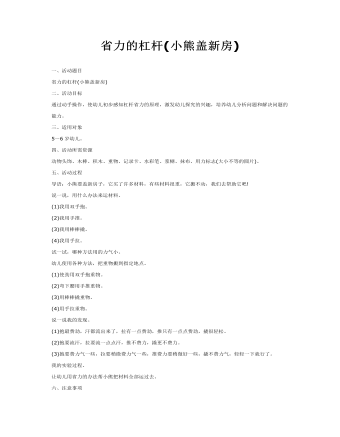
科学教案:小熊盖新房(省力的杠杆)
二、活动目标通过动手操作,使幼儿初步感知杠杆省力的原理,激发幼儿探究的兴趣,培养幼儿分析问题和解决问题的能力。三、适用对象5~6岁幼儿。四、活动所需资源动物头饰、木棒、积木、重物、记录卡、水彩笔、浆糊、抹布、用力标志(大小不等的圆片)。五、活动过程导语:小熊要盖新房子,它买了许多材料,有些材料很重,它搬不动,我们去帮助它吧!说一说,用什么办法来运材料。
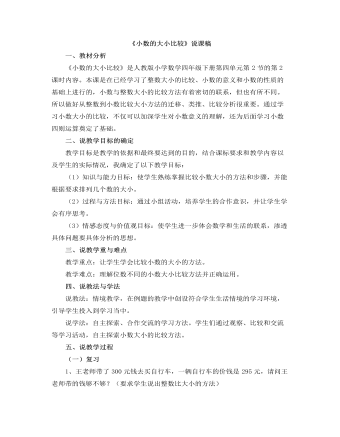
小学数学人教版四年级下册《小数的大小比较》说课稿
四、说教法与学法说教法:情境教学,在例题的教学中创设符合学生生活情境的学习环境,引导学生投入到学习当中。说学法:自主探索、合作交流的学习方法。学生们通过观察、比较和交流等学习活动,自主探索小数大小的比较方法。五、说教学过程(一)复习 1、王老师带了300元钱去买自行车,一辆自行车的价钱是295元,请问王老师带的钱够不够?(要求学生说出整数比大小的方法) 2、在下列各数按从大到小的顺序排列,你是怎样比较的? 999 1000 758 786小结:当整数位数不同时,位数多的那个数就大。当整数数位相同时,从高位开始比较,按数位顺序一位一位地比,哪一位的数大,那个数就大,就不再比下一位了。 3、小明带了14元8角,到自选商场买一支钢笔,结果发现一支钢笔的价钱是13.50元,那么小明带的钱够吗? (设计意图:这样的设计从旧知识导入,可以分散本节课的教学难点,为学习新知识做好铺垫。)
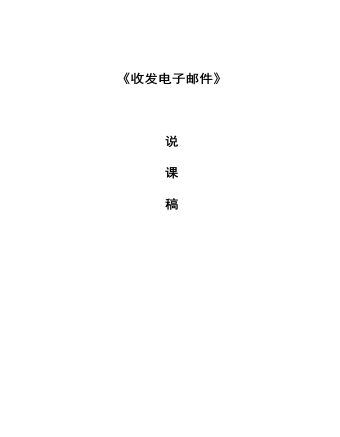
《收发电子邮件》说课稿
(一)教材地位和作用 《收发电子邮件》一课选自人教版小学信息技术五年级上册的内容。本课在整个网络知识中占有非常重要的地位,是我们下节课学习的基础,在当今快节奏的社会中,电子邮件是网上信息传递的重要手段之一。(二)教学目标: 1、知识目标:了解电子邮件的概念和格式,掌握利用电子邮件与人交流的方法 2、过程与方法:通过让学生实践、主动参与、勤于动手、乐于探索的学习习惯和与他人合作学习的能力。
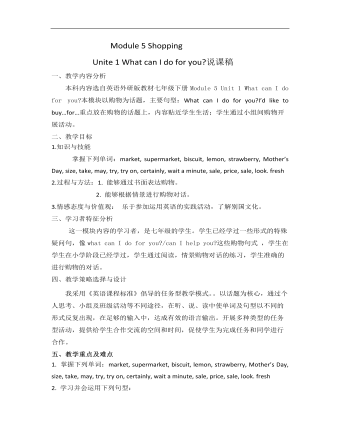
初中英语外研版七年级下册《Module 5 Shopping》说课稿
二、教学目标1.知识与技能掌握下列单词:market, supermarket,biscuit, lemon, strawberry, Mother’s Day, size, take, may, try, try on,certainly, wait a minute, sale, price, sale, look. fresh2.过程与方法:1. 能够通过书面表达购物。2. 能够根据情景进行购物对话。3.情感态度与价值观:乐于参加运用英语的实践活动,了解别国文化。三、学习者特征分析这一模块内容的学习者,是七年级的学生。学生已经学过一些形式的特殊疑问句,像what can I do for you?/can I help you?这些购物句式 ,学生在学生在小学阶段已经学过,学生通过阅读,情景购物对话的练习,学生准确的进行购物的对话。
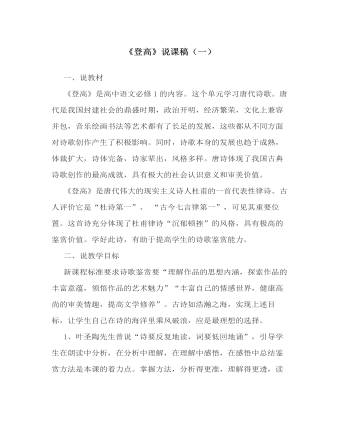
《登高》说课稿(一) 统编版高中语文必修上册
学生借助对对联的赏析,回味杜甫穷年漂泊的一生,体会杜甫作为一个深受儒家思想影响的读书人,忠君念阙,心系苍生的伟大情怀。(这一设计理念源于孟子所云:“诵其文,读其诗,不知其人,可乎?是以论其世也。”知人论世是鉴赏诗歌的第一步 )(二)研读课文1、初读,朗读吟诵,感知韵律美。要求学生读准字音,读懂句意,体会律诗的节奏、押韵的顺畅之美。2、再读,披词入情,感受感情美。让学生用一个字概括这首诗的情感内容。(此教学设计是从新课标要求的文学作品应先整体感知,培养学生归纳推理的逻辑思维能力出发进行的设计。)其答案是一个“悲”字,由此辐射出两个问题:诗人因何而“悲”?如何写“悲”?(此问题设计顺势而出,目的在于培养学生探究问题的能力。)
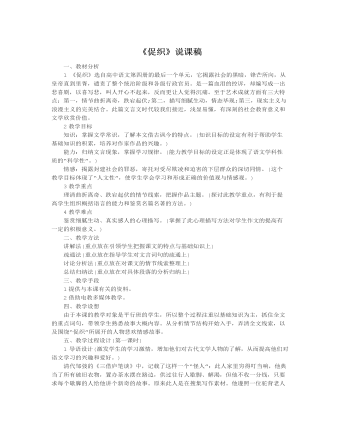
《促织》说课稿2020-2021学年统编版高中语文必修下册
蒲松龄(1640——1715)字留仙,一字剑臣,号柳泉居士。山东淄川(今淄博)人。清代小说家,出身于没落地主家庭。天资聪明,学问深厚,十九岁时连中县、府、道三个第一,但此后屡应省试不第,年七十一,始被补上岁贡生,一生忧郁自伤,穷愁潦倒。从二十岁左右开始写作,历时二十余年,创作了文言短篇小说集《聊斋志异》。另有诗、文集《聊斋诗集》、《聊斋文集》。《聊斋志异》是蒲松龄倾力创作的文言短篇小说集。“聊斋”是作者的书斋名。“志异”就是记述花妖狐鬼及其他一些荒诞不经的奇闻轶事。作者巧妙地通过这些离经虚幻的故事,大胆地揭露社会多方面的黑暗现实,赞美了青年男女敢于冲破封建礼教樊篱的精神,抒发了作者自己满腔的“孤愤”。郭沫若曾题蒲松龄故居联:“写鬼写妖,高人一等;刺贪刺虐,入木三分。”老舍题联:“鬼狐有性格,笑骂成文章。”简明而生动地道出了《聊斋志异》的文学特点。
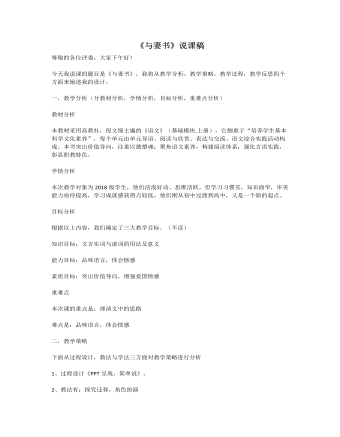
《与妻书》说课稿2020—2021学年统编版高中语文下册
二,教学策略下面从过程设计,教法与学法三方面对教学策略进行分析1、过程设计《PPT呈现,简单说》。2、教法有:探究迁移,角色扮演3、学法有:小组讨论,自主学习,三,教学过程本次课前预习,课中学习,课后练习三个环节。(一)课前准备课前准备环节分前置性学习和课前诊断。前置性学习可通过微课,教材等课程资源,对相关知识进行自学,了解背景,疏通文义,实行小检测。(二)课中学习课中学习环节分自主学习,合作探究,拓展延伸三个步骤。步骤一,自主学习文言实词与虚词的用法及意义,总结规律。步骤二,围绕题目展开,理清文中思路,并品味语言,体悟情感。学生先自由讨论发言,分析品味文中的语言所包含的情感,揣摩人物的心理,说话的语气,然后读出来,大家分享。老师也可以参与,师生共读共赏,最后可以听听名家朗诵音频,进行多向比较鉴赏。
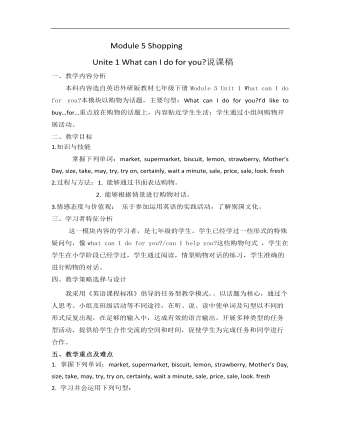
初中英语外研版七年级下册《Module 5 Shopping》说课稿
二、教学目标1.知识与技能掌握下列单词:market, supermarket,biscuit, lemon, strawberry, Mother’s Day, size, take, may, try, try on,certainly, wait a minute, sale, price, sale, look. fresh2.过程与方法:1. 能够通过书面表达购物。2. 能够根据情景进行购物对话。3.情感态度与价值观:乐于参加运用英语的实践活动,了解别国文化。
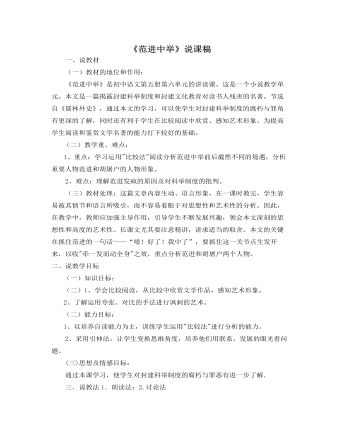
部编版语文九年级上册《范进中举》说课稿
一、说教材(一)教材的地位和作用:《范进中举》是初中语文第五册第六单元的讲读课。这是一个小说教学单元。本文是一篇揭露封建科举制度和封建文化教育对读书人残害的名著。节选自《儒林外史》,通过本文的学习,可以使学生对封建科举制度的腐朽与罪角有更深的了解,同时还有利于学生在比较阅读中欣赏、感知艺术形象。为提高学生阅读和鉴赏文学名著的能力打下较好的基础。(二)教学重、难点:1、重点:学习运用"比较法"阅读分析范进中举前后截然不同的境遇,分析重要人物范进和胡屠户的人物形象。2、难点:理解范进发疯的原因及对科举制度的批判。(三)教材处理:这篇文章内容生动、语言形象,在一课时教完,学生容易被其情节和语言所吸引,而不容易着眼于对思想性和艺术性的分析。因此,在教学中,教师应加强主导作用,引导学生不断发展兴趣,领会本文深刻的思想性和高度的艺术性。长课文尤其要注意精讲,讲求适当的取舍。
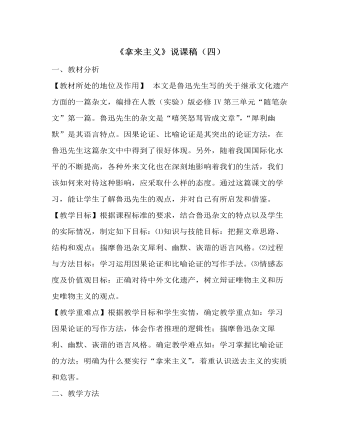
《拿来主义》说课稿(四) 统编版高中语文必修上册
【教学目标】根据课程标准的要求,结合鲁迅杂文的特点以及学生的实际情况,制定如下目标:⑴知识与技能目标:把握文章思路、结构和观点;揣摩鲁迅杂文犀利、幽默、诙谐的语言风格。⑵过程与方法目标:学习运用因果论证和比喻论证的写作手法。⑶情感态度及价值观目标:正确对待中外文化遗产,树立辩证唯物主义和历史唯物主义的观点。【教学重难点】根据教学目标和学生实情,确定教学重点如:学习因果论证的写作方法,体会作者推理的逻辑性;揣摩鲁迅杂文犀利、幽默、诙谐的语言风格。确定教学难点如:学习掌握比喻论证的方法;明确为什么要实行“拿来主义”,着重认识送去主义的实质和危害。二、教学方法教学应坚持“以学生为主体”的原则,尽可能发挥学生学习的能动性和主动性,培养学生独立思考的能力,调动学生学习积极性,因此本文采用“疑问教学法”相对合适。

新人教版高中英语必修3Unit 1 Festivals and Celebrations教学设计二
1. Ss look at the picture and scan the passage to understand the main idea while teacher is giving the following questions to inspire Ss to think.*Where are those people?*What are they doing?*Why are they so excited?2. Ss complete the passage with the appropriate -ing form. Then discuss and check the answers with class.Answers: boring, interesting, taking, exciting, amazing3. The teacher raises questions for the students to discuss and encourages them to express their opinions.*Do you like La Tomatina? Why or why not?4. Each group representative reports the discussion result, the teacher gives feedback and the evaluation.Step 6 PracticeActivity 41. Ss complete the Ex 2 in Using structures.2. Check the answers after finishing the exercises.①The dragon boat races are the most exciting part of the Dragon Boat Festival.② The children were excited to go Easter egg hunting.③What an amazing performance! This is the best music festival I have ever been to.④We were amazed by her funny-looking hat.⑤His inspiring speech at the conference won the admiration/ favour of the audience.⑥This is a challenging game to test your memory and observation capabilities. 3. T asks Ss to finish Ex 3 and 4 in Using structures by themselves, then check the answers with class.Step 6 Homework1. Understand and master the functions and usage of the -ing form;2. Finish the other exercises in Using structures.1、通过本节内容学习,学生是否理解和掌握动词-ing形式作定语和表语的功能和意义;2、通过本节内容学习,学生能否在理解文段内容的基础上,根据上下文语境和表达逻辑,能正确运用动词-ing形式描述节日庆典。3、通过本节内容学习,学生是否归纳和积累用于表达情绪的相关词汇。

新人教版高中英语必修3Unit 1 Festivals and Celebrations教学设计一
本板块的活动主题是“谈论节日活动”(Talk about festival activities),主要是从贴近学生日常生活的角度来切入“节日”主题。学生会听到发生在三个国家不同节日场景下的简短对话,对话中的人们正在参与或将要亲历不同的庆祝活动。随着全球化的进程加速,国际交流日益频繁,无论是国人走出国门还是外国友人访问中国,都已成为司空见惯的事情。因此,该板块所选取的三个典型节日场景都是属于跨文化交际语境,不仅每组对话中的人物来自不同的文化背景,对话者的身份和关系也不尽相同。1. Master the new words related to holiday: the lantern, Carnival, costume, dress(sb)up, march, congratulation, congratulate, riddle, ceremony, samba, make - up, after all. 2. To understand the origin of major world festivals and the activities held to celebrate them and the significance of these activities;3. Improve listening comprehension and oral expression of the topic by listening and talking about traditional festivals around the world;4. Improve my understanding of the topic by watching pictures and videos about different traditional festivals around the world;5. Review the common assimilation phenomenon in English phonetics, can distinguish the assimilated phonemes in the natural language flow, and consciously use the assimilation skill in oral expression. Importance:1. Guide students to pay attention to the attitude of the speaker in the process of listening, and identify the relationship between the characters;2. Inspire students to use topic words to describe the festival activities based on their background knowledge. Difficulties:In the process of listening to the correct understanding of the speaker's attitude, accurately identify the relationship between the characters.

新人教版高中英语必修3Unit 2 Morals and Virtues教学设计二
Activity 41. Students complete the task of activity 4, then teachers and students check the answers. 2. The teacher organized the students to work together and asked them to use the tables and mind maps sorted out before to retold the important choices in Lin Qiaozhi's life and their resultsStep 5 Language points1. The teacher asks the students to read the text carefully, find out the core words and long and difficult sentences in the text and draw lines, understand the use of vocabulary, and analyze the structure of long and difficult sentences. 2. The teacher explains and summarizes the usage of core vocabulary and asks the students to take notes. 3. The teacher analyzes and explains the long and difficult sentences that the students don't understand, so that the students can understand them better. Step 6 Homework1. Read the text again, in-depth understanding of the text; 2. Master the use of core vocabulary and understand the long and difficult sentences. 3. Complete relevant exercises in the guide plan. 1、通过本节内容学习,学生是否理解和掌握阅读文本中的新词汇的意义与用法;2、通过本节内容学习,学生能否结合文本特点总结林巧稚的人生原则和人格品质特征;3、通过本节内容学习,学生能否针对人生抉择发表自己的看法;能否全面地、客观地、理性地看待问题,进而对道德和人性有更加深入的思考和理解。

新人教版高中英语必修3Unit 2 Morals and Virtues教学设计三
The joke set her crying.这个玩笑使她哭起来。Step 5 ReadingActivity 31. Students read the small text in activity 3. The teacher provides several small questions to check whether students understand the content of the text and the ideographic function of the -ing form in the text.*Where are those people?*Why did Dr Bethune come to China?*How did he help the Chinese people during the war?*What did Chairman Mao Zedong say about him?2. Ss try to rewrite some sentences using the -ing form. Then check the answers. When checking the answers, the teacher can ask different students to read the rewritten sentences and give comments.Answers:1. he became very interested in medicine, deciding to become a doctor.2. …after hearing that many people were dying in the war.3. Helping to organise hospitals, he taught doctors and nurses, and showed people how to give first aid./ He helped to organise hospitals, teaching doctors and nurses, and showing people how to give first aid.4. …praising Dr Bethune as a hero to be remembered in China.Step 6 PracticeActivity 4Students complete grammar activities 2 and 3 on page 69 of the workbook.Step 6 Homework1. Understand and master the functions and usage of the -ing form;2. Finish the other exercises in Using structures.1、通过本节内容学习,学生是否理解和掌握动词-ing形式作宾语补足语语和状语语的功能和意义;2、通过本节内容学习,学生能否正确使用动词-ing形式描述人物的行为、动作及其经历;3、通过本节内容学习,学生能否独立完成练习册和导学案中的相关练习。

新人教版高中英语必修3Unit 3 Diverse Cultures教学设计三
The price is the same as(the price was)before the war.价格与战前相同。(4)定语从句中的“关系代词+助动词be”可以省略。The ticket(that/which was)booked by his sister has been sent to him.他妹妹订的那张票已送到了他那里。Step 5 PracticeActivity 3(1) Guide students to complete the four activities in the Using Structures part of exercise book, in which activities 1 and 2 focus on ellipsis in dialogue answers, activity 3 focus on signs and headlines, two typical situations where ellipsis is used, and activity 4 focus on ellipsis in diary, an informal style.(2) Combine the examples in the above activities, ask students to summarize the omitted situations in groups, and make their own summary into a poster, and post it on the class wall after class to share with the class.(This step should give full play to the subjectivity of students, and teachers should encourage students to conclude different ellipsis phenomena according to their own understanding, they can conclude according to the different parts omitted in the sentence.)Step 6 Homework1. Understand and master the usages of ellipsis;2. Finish the other exercises in Using structures of Workbook.1、通过本节内容学习,学生是否理解和掌握省略的用法;2、通过本节内容学习,学生能否根据上下文语境或情景恢复句子中省略的成分,体会使用省略的效果;3、通过本节内容学习,学生能否独立完成练习册和导学案中的相关练习。

新人教版高中英语必修3Unit 3 Diverse Cultures教学设计二
(2)Consolidate key vocabulary.Ask the students to complete the exercises of activity 6 by themselves. Then ask them to check the answers with their partners.(The first language:Damage of the 1906 San Francisco earthquake and fire.A second language: Yunnan - one of the most diverse provinces in China).Step 5 Language points1. The teacher asks the students to read the text carefully, find out the more words and long and difficult sentences in the text and draw lines, understand the use of vocabulary, and analyze the structure of long and difficult sentences.2. The teacher explains and summarizes the usage of core vocabulary and asks the students to take notes.3. The teacher analyzes and explains the long and difficult sentences that the students don't understand, so that the students can understand them better.Step 6 Homework1. Read the text again, in-depth understanding of the text;2. Master the use of core vocabulary and understand the long and difficult sentences.3. Complete relevant exercises in the guide plan.1、通过本节内容学习,学生是否理解和掌握阅读文本中的新词汇的意义与用法;2、通过本节内容学习,学生能否结合文本特点了解文章的结构和作者的写作逻辑;3、通过本节内容学习,学生能否了解旧金山的城市风貌、文化特色,以及加利福尼亚州的历史,体会多元文化对美国的影响。

新人教版高中英语必修3Unit 3 Diverse Cultures教学设计一
Activity 81.Grasp the main idea of the listening.Listen to the tape and answer the following questions:Who are the two speakers in the listening? What is their relationship?What is the main idea of the first part of the listening? How about the second part?2.Complete the passage.Ask the students to quickly review the summaries of the two listening materials in activity 2. Then play the recording for the second time.Ask them to complete the passage and fill in the blanks.3.Play the recording again and ask the students to use the structure diagram to comb the information structure in the listening.(While listening, take notes. Capture key information quickly and accurately.)Step 8 Talking Activity 91.Focus on the listening text.Listen to the students and listen to the tape. Let them understand the attitudes of Wu Yue and Justin in the conversation.How does Wu Yue feel about Chinese minority cultures?What does Justin think of the Miao and Dong cultures?How do you know that?2.learn functional items that express concerns.Ask students to focus on the expressions listed in activity. 3.And try to analyze the meaning they convey, including praise (Super!).Agree (Exactly!)"(You're kidding.!)Tell me more about it. Tell me more about it.For example, "Yeah Sure." "Definitely!" "Certainly!" "No kidding!" "No wonder!" and so on.4.Ask the students to have conversations in small groups, acting as Jsim and his friends.Justin shares his travels in Guizhou with friends and his thoughts;Justin's friends should give appropriate feedback, express their interest in relevant information, and ask for information when necessary.In order to enrich the dialogue, teachers can expand and supplement the introduction of Miao, dong, Lusheng and Dong Dage.After the group practice, the teacher can choose several groups of students to show, and let the rest of the students listen carefully, after listening to the best performance of the group, and give at least two reasons.
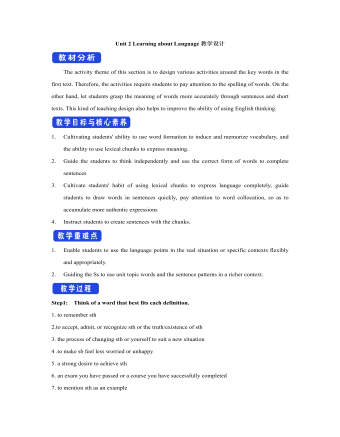
新人教版高中英语选修2Unit 2 Learning about Language教学设计
The activity theme of this section is to design various activities around the key words in the first text. Therefore, the activities require students to pay attention to the spelling of words. On the other hand, let students grasp the meaning of words more accurately through sentences and short texts. This kind of teaching design also helps to improve the ability of using English thinking.1. Cultivating students' ability to use word formation to induce and memorize vocabulary, and the ability to use lexical chunks to express meaning.2. Guide the students to think independently and use the correct form of words to complete sentences3. Cultivate students' habit of using lexical chunks to express language completely, guide students to draw words in sentences quickly, pay attention to word collocation, so as to accumulate more authentic expressions4. Instruct students to create sentences with the chunks.1. Enable students to use the language points in the real situation or specific contexts flexibly and appropriately.2. Guiding the Ss to use unit topic words and the sentence patterns in a richer context.Step1: Think of a word that best fits each definition.1. to remember sth2.to accept, admit, or recognize sth or the truth/existence of sth3. the process of changing sth or yourself to suit a new situation4 .to make sb feel less worried or unhappy5. a strong desire to achieve sth